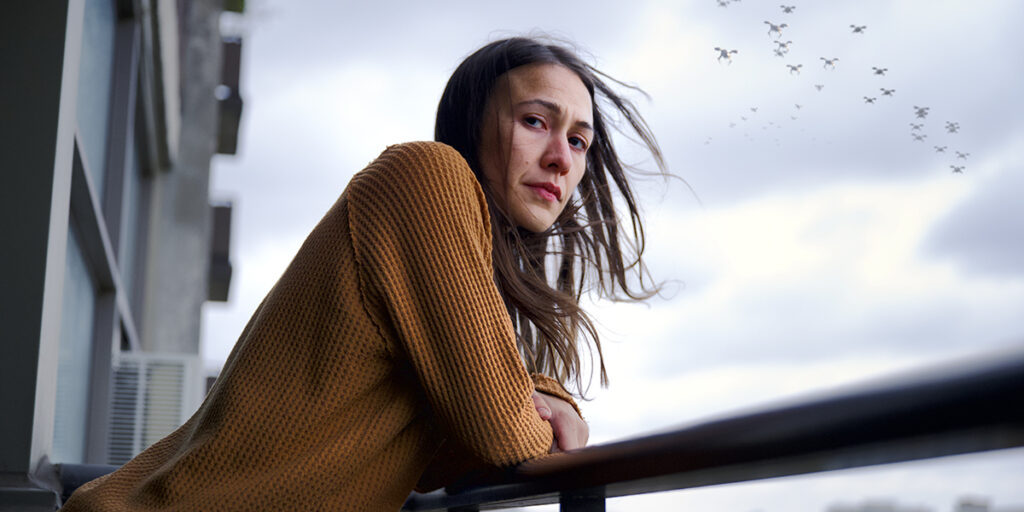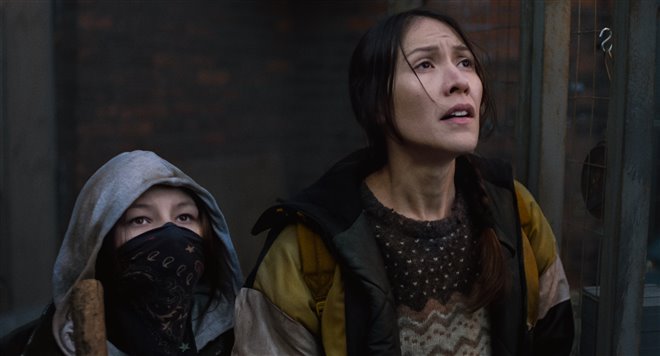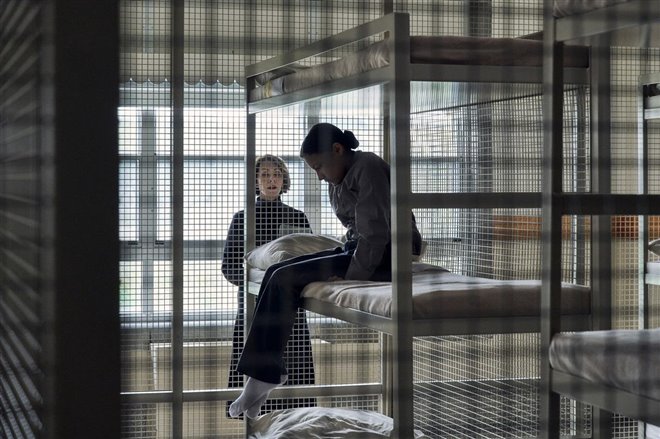Night Raiders is both a sci-fi thriller and a stirring portrait of a mother and daughter—and the communities they carry with them—fighting against all odds to maintain a way of life and hope for the future.
This is one in a series of reviews from the 2021 Toronto International Film Festival (TIFF), during which I focused on films directed by women; you can find my other TIFF 2021 reviews here.

Several years ago, a fellow media scholar recommended Cree-Métis filmmaker Danis Goulet’s Wakening (2013) to me. A remarkable short film (thankfully available on YouTube), Wakening builds an entire world in less than nine minutes, exploring the power of Indigenous legends, monsters and heroes in a richly realized post-apocalyptic future.
Ever since, I have waited anxiously for a feature-length story by Goulet to grace my screen. Night Raiders, a haunting and intricate film that brings the painful history of Canada’s residential school system into a war-torn, eerily conceivable future, was both exactly what I longed for and so much more.
Described in promotional materials as an Indigenous sci-fi thriller, Night Raiders feels both familiar in its exploration of a dystopian future—vis-à-vis the enhanced role of technology, extreme government overreach, and the degradation of marginalized communities—and innovative in its dedication to history and the power of “old stories.”
Goulet anchors the film through her experience in and with Indigenous communities and traditions of Indigenous storytelling. She writes, for example, of her experience visiting Standing Rock in North Dakota:
“The people standing up at Standing Rock talked about the Black Snake prophesy: a snake that would cross the land and devour everything in its path, about it being the pipeline. It sent shivers up my spine to think about it that way. But also, it was such a beautiful metaphor, so poetic, so rich and so wise. I wanted to bring an element of that into Night Raiders, treating it with the respect and authenticity that it deserves and not letting it fall into the ‘mystical Indian’ trope.”
The dedication shown in Night Raiders to authentic Indigenous representation extends both in front and behind the camera, as the film’s cast and crew are largely Indigenous. Goulet and her team also sought out as many Cree collaborators as possible, even building a mentorship program into the production. Further emphasizing the importance of cross-cultural connections and solidarity across communities, Night Raiders is a joint Canadian/New Zealand venture, executive produced by Taika Waititi and building in Māori elements alongside North American Indigenous ones.

In the film, it’s 2043, and a civil war has torn apart North America leaving the disenfranchised living on the edges of a precarious existence: no citizenship or status, unpredictable access to food and housing, and with no protection from illness or state violence. The world Niska (Elle-Máijá Tailfeathers) and 11-year-old daughter Waseese (Brooklyn Letexier-Hart) live and survive in would be considered, by anyone’s standards, a nightmare—but it presents a special kind of anguish for parents.
Children in this near future are considered wards of the government, torn away from home at the age of five to begin their “education” in Academy schools. Once there, they are indoctrinated to be obedient subjects of the state. While they are presumably well-fed and provisioned in the schools, they are also subject to brutal training regimes, mistreatment, forced assimilation and brainwashing.
For six years, Niska has been on the run with her daughter, living off the land to prevent Waseese’s compulsory enrollment at the Academy, after which children are not allowed to see their parents ever again.
Then, an accident forces Niska to make an impossible choice: Turn over her daughter to the authorities or watch Waseese die from a rampant infection Niska does not have the resources to heal. At first, a heartbroken Niska manages to convince herself Waseese is better off in the safe and regulated environment of the school, but her personal misgivings blossom into growing dread when she meets a group of Cree freedom-fighters who warn of the schools’ nefarious motives and have taken to rescuing children one-by-one.
Standing alongside these warriors, who believe Niska’s arrival fulfills a prophecy through which the children can be brought to safety, Niska determines to infiltrate the Academy and reclaim her daughter. Meanwhile, at the school, Waseese tries to resist the efforts of her state-sponsored oppressors, but one child can only fight a monolithic system for so long.

In her introduction to the film, Goulet reminds viewers how, despite its future setting, everything we see is true. The apocalyptic visions we’d like to imagine are only a speculative future are echoes of our very real past. Seven generations of Indigenous children were forcibly taken from their parents in Canada and sent to residential schools so they could be assimilated into anglicized culture and distanced from their communities of origin. In Canada, these schools were in operation from the 1830s all the way into the 1990s. Similar practices were in place in the United States, Australia and New Zealand, among others—not to mention the wide-sweeping legacy of colonialism under which Indigenous communities have been and still are destroyed, marginalized, contained, and controlled across the globe.
While Night Raiders shares visual elements and aspects of its premise with other post-apocalyptic films like Children of Men (2006, directed by Alfonso Cuarón) and The Girl with All the Gifts (2016, directed by Colm McCarthy), its amalgam of past and future and its emotional weight—made vivid by Tailfeathers and Letexier-Hart alongside a superb ensemble cast—means it also stands on its own at the cusp of a new and vital age of Indigenous filmmaking.
Vivid and meticulous in its conceptualization and staging, Night Raiders delivers a poignant message about how and why we must heed the old stories. It is, at once, a sci-fi thriller and a stirring portrait of a mother and daughter—and the communities they carry with them—fighting against all odds to maintain a way of life and hope for the future.
Up next:





